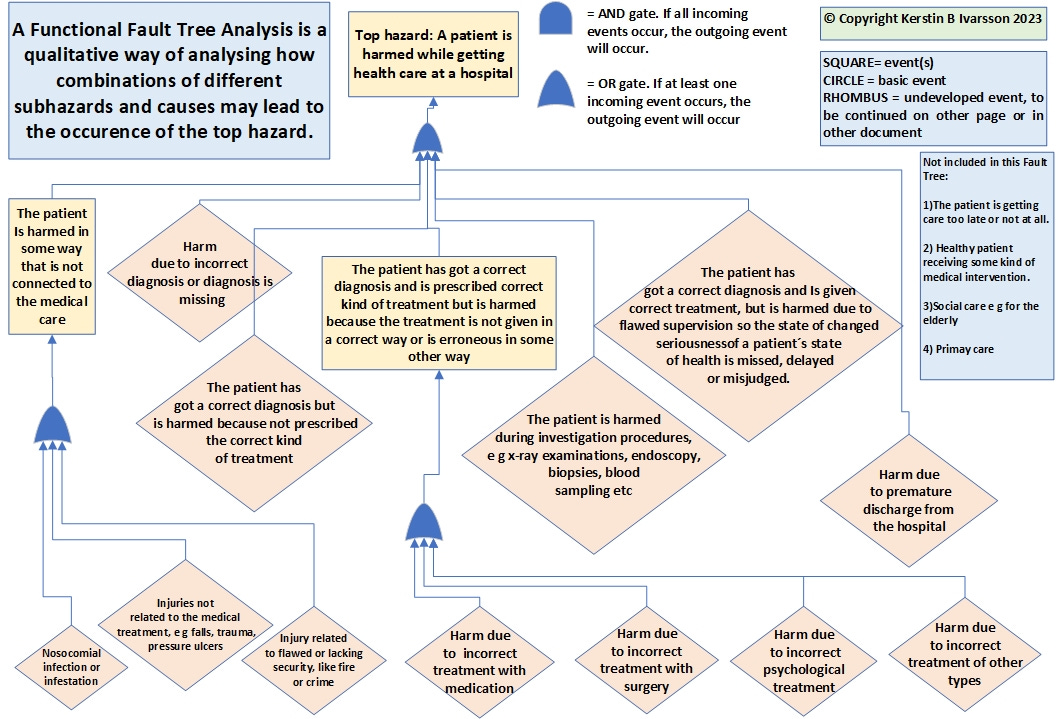Hazards describing different ways a patient might get harmed while receiving care at a hospital
Upper level of a Functional Fault Tree Analysis
Introduction
In this text I will describe an (incomplete) analysis of a subsystem of the system described in this text: System-level safety hazards of a generic health care and welfare system on national level
All hazards in this text are sub-hazards of hazard #2 in the abovementioned text, but this analysis does not comprise all sub-hazards of hazard #2.
A Functional Fault Tree Analysis (FTA) is a qualitative way of analysing how combinations of different sub-hazards and causes may lead to the occurence of the top hazard.
The Functional Fault Tree is shown in the picture below. See explanations further down in this text.
System definition
This subsystem includes the sub-hazards that might cause harm to a patient while getting health care at a hospital, and some sub-sub-hazards.
The following is NOT included:
The patient is getting care too late or not at all (hazard #1 in the previous text).
Healthy patient receiving some kind of medical intervention (hazard #3 in the previous text)
Social care e g for the elderly
Primay care
Explanation of graphical FTA symbols
The symbols used are explained in the diagram, but on this upper level no AND-gates are used. For OR-gates, if at least one incoming event occurs, the outgoing event will occur. AND-gates are used when two or more events all must occur in order to result in the outgoing event, that is, when a certain combination of hazards occurs simultaneously. When you add barriers in order to prevent a hazard, you insert an AND-gate where failure of that barrier constitutes the other input.
Rhombes are used when you run out of space on a small sheet and/or continue the work elsewhere, or when you decide not to analyze further even if you could do that. Rhombes indicate undeveloped events, and there are many in this example, for further work. A circle implies that further analysis is not possible, it is a basic event.
The hazards
Below are the same hazards as in the graphic diagram, and it works well to explain how they relate to each other only via text in this particular case, because no AND-gates are used, and because just a small analysis.
Top hazard: A patient is harmed while getting health care at a hospital
The patient Is harmed in some way that is not connected to the medical care
Nosocomial infection or infestation
Injuries not related to the medical treatment, e g falls, trauma, pressure ulcers
Injury related to flawed or lacking security, like fire or crime
Harm due to incorrect diagnosis or diagnosis is missing
The patient has got a correct diagnosis but is harmed because not prescribed the correct kind of treatment
The patient has got a correct diagnosis and is prescribed correct kind of treatment but is harmed because the treatment is not given in a correct way or is erroneous in some other way
Harm due to incorrect treatment with medication
Harm due to incorrect treatment with surgery
Harm due to incorrect psychological treatment
Harm due to incorrect treatment of other types
The patient is harmed during investigation procedures, e g x-ray examinations, endoscopy, biopsies, blood sampling etc
The patient has got a correct diagnosis and Is given correct treatment, but is harmed due to flawed supervision so the state of changed seriousnessof a patient´s state of health is missed, delayed or misjudged.
Harm due to premature discharge from the hospital
Please comment
Please comment if you find something missing or wrong on the level below the top hazard in this example, or if you want to ask or comment about something else.
This is just a part of a larger analysis, in order to explain this method, and to give an overview of the possible ways a patient might get harmed in a hospital.


